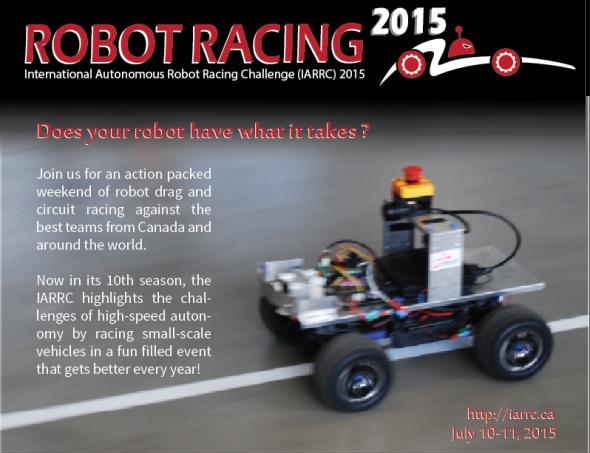Not much on live TV compares with the tension of watching human race car drivers risk possible injury or death at speeds of hundreds of miles per hour. A split second of bad timing can quickly transform a tight, controlled race into chaos as machines spin out of control, careen off walls or smash directly into one another. By comparison, the rise of robot racing with flying drones or self-driving cars aims to attract both old and new racing fans without putting human lives at risk. The big question is whether human fans will tune in to watch speedy robots race without the added adrenaline rush of danger.
The 2015 International Autonomous Robot Racing Challenge was shockingly thrill! And it was a very exciting event with multiple teams showing big gains in terms of racing autonomy. The weather was rather wet on Friday, but Saturday was gorgeous, sunny and hot, and we had a great day of drag and circuit racing. All teams demonstrated true autonomy on the drag course, and both Waterloo and Western completed the entire circuit course loop autonomously.
The final standings and points are detailed on the Results page, but to spare you the suspense, it was 1st place to Waterloo, 2nd to WCI, 3rd to Western and 4th to Georgia Tech.
Competitions are held all around the world now!
Like this one took place in 2015.
Drone racing has already existed for some time as an underground sport that pits nimble quadcopters against one another as they fly through aerial racetracks made of brightly-lit rings, illuminated barriers and pipe tunnels. The effect of watching flying robots racing among colorful obstacle courses is similar to watching a real-life video game in many ways. Such spectacle has inspired several companies that want to transform drone racing from a hobby into an official televised sport event. On Jan. 26, a new company called the Drone Racing League announced its inaugural racing season with a focus on giving spectators a thrilling, high-definition (HD) view of the race from the drones’ point of view, according to Quartz. It’s a unique viewing experience that may be just enough to win over racing fans even without human life and limb on the line.
Robot Racing became a thing at University Of Waterloo in 2014.
After the disappointment of cancelling the 2013 event due to lack of interest, we are very pleased to announce that Robot Racing will once again be held in 2014. We’re refining the competition rules now with our new competition organizing committee, and have confirmed multiple teams for the competition in 2014. The prizes, venue and competition elements will all remain the same, and the dates and refined rules will be posted in the coming weeks. Looking forward to a great year of racing.
The novelty of watching driverless vehicles pull off robot racing without humans behind the controls may prove enough to get human spectators interested. Such robot racing goes beyond even drone racing that still requires human operators to pilot them remotely from the ground. In addition, Formula E plans to start off by having the robot racing take place just before the main events featuring human drivers.
Still, the question remains as to whether robot car racing will appeal to the broader racing car audiences for NASCAR and Formula One. In 2015, aglobal survey of 35,000 Formula One fans asked what was the main reason they watched the races. One of the top answers included “technical innovations.” On the other hand, the most popular answer for watching Formula One was “the speed and risks involved.”



